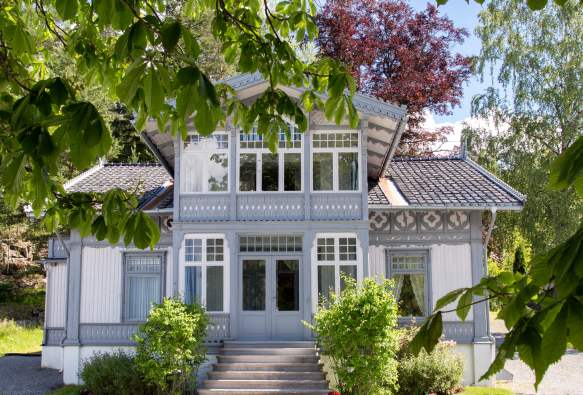Roald Amundsen nasceu neste dia, 16 Julho 1872. A Noruega seu país de origem celebra o seu 150º aniversário. A sua casa Uranienborg reabriu, após a pandemia, mesmo a tempo de celebrar o aniversário.
Este ano 2020, celebram-se os 150 anos do nascimento do herói polar Roald Amundsen. O aniversário está a ser comemorado com a publicação de um diário e uma “ressurreição” digital do explorador polar. Conhecido como um dos pilares da Heroic Age da expedição polar.
Suas feitos, que abrangeram as regiões polares do norte e do sul da Terra durante as primeiras décadas do século 20, são lendárias mesmo para os padrões de hoje.
A casa de Roald Amundsen, Urien, em Nordre Follo, foi reaberta após dois anos de pandemia. A vila de estilo suíço, hoje um museu, está quase intocada e tem a mesma aparência de quando Amundsen morreu, em 18 Junho 1928.
A reabertura ocorrendo a tempo de comemorar o 150º aniversário do herói polar. Durante a pandemia, o museu lançou uma versão digital da casa de Amundsen, onde todos os cantos e recantos foram digitalizados em 3D. Neste ano de aniversário dos 150 anos, o museu tem várias novidades.
Entre outras coisas, o explorador polar reaparece “vivo”, claro em que em versão digital.
Já se passaram 111 anos desde que Amundsen se tornou a primeira pessoa a chegar ao Pólo Sul, um feito que talvez reine supremo em todas as suas muitas expedições às extremidades do mundo.
Durante suas expedições, Amundsen escreveu diários, que foram publicados em forma de livro. Mas em um diário pessoal de 1925, Amundsen descreve a sua relação com seu grande amor. A mulher casada Elisabeth "Kiss" Bennett. O diário foi mantido em sigilo por 50 anos, antes de ser aberto nos Arquivos da Biblioteca Nacional, Noruega, em 1990.
Today, 16 July, Roald Amundsen would celebrate his 150th anniversary. This year marks 150 years since the birth of polar hero Roald Amundsen. The anniversary is being commemorated with the publication of a diary and a digital “resurrection” of the polar explorer.
Roald Amundsen’s home Urien in Nordre Follo has now been reopened after two years of pandemic. The Swiss-style villa, which today is a museum, is almost untouched and looks the way it did when Amundsen disappeared in 1928.
The opening is taking place just in time to celebrate the polar hero’s 150th anniversary. During the pandemic, the museum launched a digital version of the Amundsen home, where every nook and cranny was 3-D scanned. This anniversary year, the museum has several new treats in store.
Among other things, the polar explorer reappears “alive,” albeit in the form of a digital version of himself.
It’s been 111 years since Amundsen became the first person to reach the South Pole, a feat that perhaps reigns supreme over all his many expeditions to the world’s extremities.
During his expeditions, Amundsen wrote diaries, which were published in book form. But in a private diary from 1925, he describes his relationship with his great love. The married woman Kiss Bennett. The diary was kept private for 50 years, before it was opened in the National Library’s archives in 1990.
Roald Amundsen’s life was full of stories. He was a global celebrity who made big headlines, but also a man who knew how to hide away. Some of the stories about Amundsen were known to the whole world, others he kept hidden for as long as he lived.
This summer, the diary will be published in book form for the very first time in a collaboration between the National Library and Follo Museum. While the successful adventurer frequently toured the world to talk about his polar achievements, he shielded his privacy very well. This diary therefore provides a unique insight into the polar explorer’s emotional life, Bache explained.
“Here we meet an Amundsen in his 50s who is happy, jealous, and full of longing and feelings. It is a story that makes him more human,” he said.
credits: © photos.com/Getty Images
Amundsen disappeared in June 1928 while taking part in a rescue mission when his plane crashed into the Arctic ocean. Amundsen, Douglas Mawson, Robert Falcon Scott, and Ernest Shackleton were key expedition leaders during the Heroic Age of Antarctic Exploration.
Recursos/ Resources: English & Norwegian
When the North Pole became the South Pole: Explore the exhibition
https://amundsen.mia.no/en/resource/1908-1910-when-the-north-pole-became-the-south-pole/
Uranienborg, explore the house ( English/ Norvegian)
https://amundsen.mia.no/en/uranienborg-2/
https://mia.no/roaldamundsen/digitalt
Stories
https://amundsen.mia.no/en/stories-2/
Resources:
https://amundsen.mia.no/en/resources/
Podcasts
Facebook Roald Amundsen's House
https://www.facebook.com/RoaldAmundsensHouse
Geração 'explorer'
16.07.2022

















